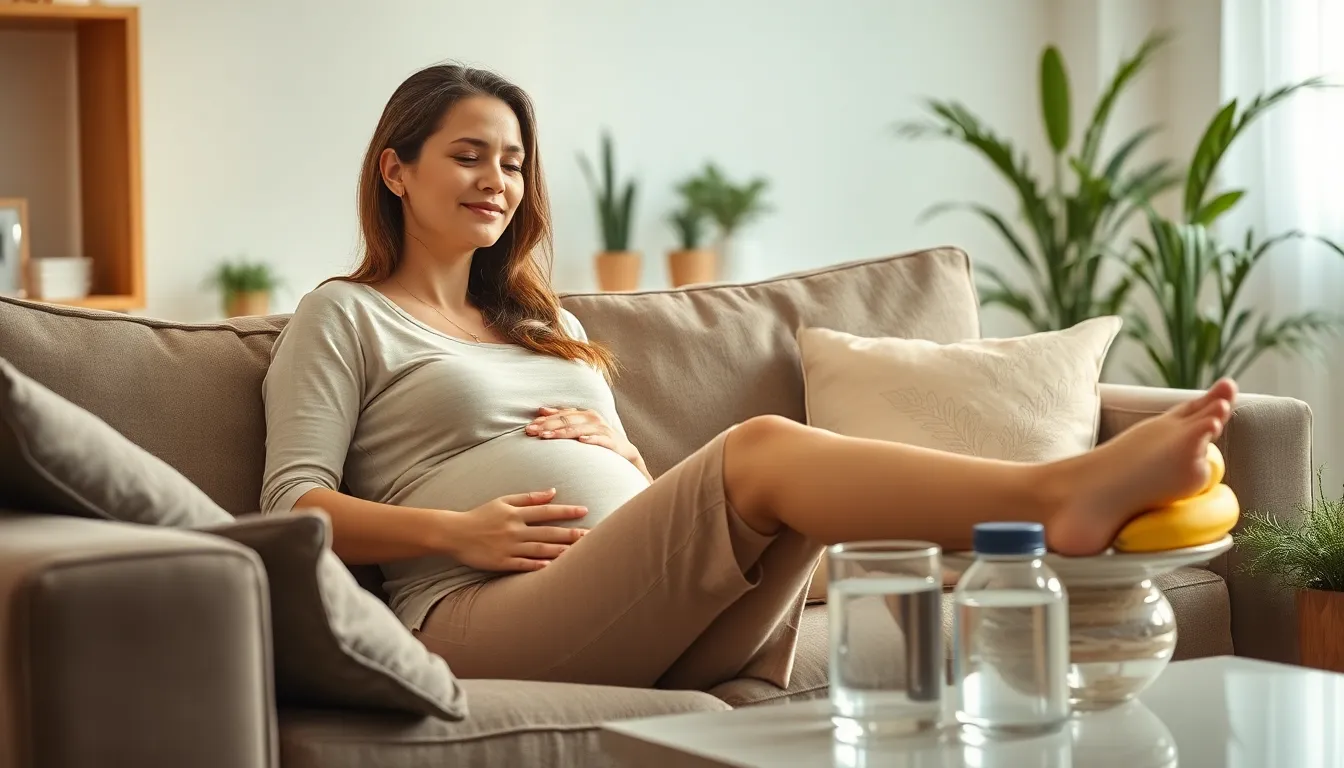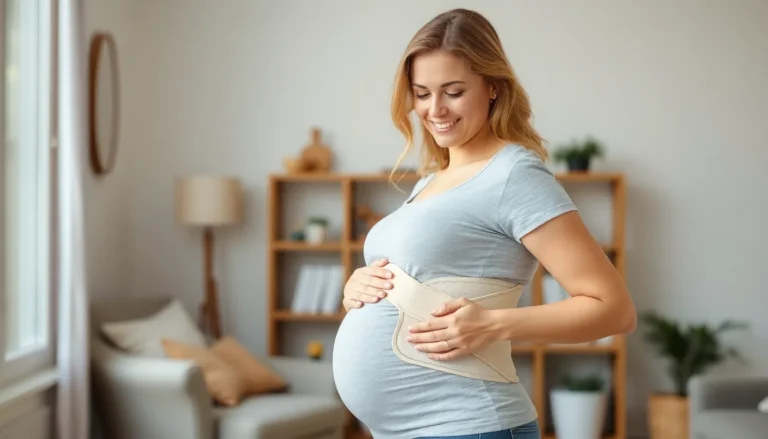Pregnancy brings a whirlwind of changes, and while many are joyful, some can be quite uncomfortable. One such discomfort is leg cramps, a common yet frustrating issue faced by many expectant mothers. These sudden and often painful muscle contractions can disrupt sleep and daily activities, leaving women searching for effective relief.
Understanding the causes of pregnancy leg cramps is essential for finding solutions. Factors like hormonal changes, increased weight, and pressure on blood vessels can all contribute to this pesky problem. Fortunately, there are several strategies and remedies that can help ease the discomfort and promote relaxation. With the right approach, relief is within reach, allowing expectant mothers to focus on the joys of pregnancy.
Table of Contents
ToggleUnderstanding Pregnancy Leg Cramps
Pregnancy leg cramps frequently occur, causing significant discomfort for expectant mothers. Recognizing the underlying causes and symptoms can help in managing these cramps effectively.
Causes of Leg Cramps During Pregnancy
- Hormonal Changes: Increased levels of progesterone relax blood vessels, which can hinder circulation and contribute to leg cramps.
- Weight Gain: Additional weight places pressure on muscles and blood vessels, often leading to cramps, particularly in the legs.
- Positioning: Sitting or standing in one position for extended periods can tighten muscles, resulting in cramping.
- Nutrient Deficiencies: Insufficient levels of calcium, potassium, or magnesium can cause muscle cramps.
- Fluid Retention: Increased body fluid and swelling in the legs create pressure on nerves, triggering cramps.
- Increased Activity: Changes in exercise routines or physical exertion levels can lead to muscle fatigue and cramping.
Common Symptoms to Look Out For
- Sudden Pain: A sharp or aching sensation often occurs in the calf or thigh muscles.
- Muscle Tightness: A hardening of the muscle may accompany the pain, making movement difficult.
- Duration: Cramps typically last from a few seconds to several minutes.
- Frequency: Leg cramps may happen at night or during periods of rest, interrupting sleep patterns.
- Swelling: Accompanying swelling in the legs could indicate additional concerns requiring further attention.
Effective Remedies for Relief

Expectant mothers can find various effective remedies to relieve leg cramps during pregnancy. These approaches often combine physical strategies and dietary modifications to ease discomfort.
Stretching Exercises
Stretching exercises provide immediate relief from leg cramps. Regularly practicing the following exercises can improve muscle flexibility and circulation:
- Calf stretches: Stand facing a wall, place the hands on the wall for support, and step back with one foot, keeping it straight while bending the front knee. Hold for 15 to 30 seconds, then switch legs.
- Toe flexes: While seated, extend one leg forward with the heel on the ground. Flex and point the toes for 10 repetitions, alternating legs.
- Ankle circles: Sit or lie down and lift one leg, rotating the ankle in circular motions, clockwise and counter-clockwise, for 10 rotations each direction.
Incorporating these stretches into a daily routine can significantly reduce the frequency of cramps.
Dietary Adjustments
Dietary adjustments can also play a crucial role in preventing leg cramps. Proper nutrition promotes muscle function and overall health:
- Increase magnesium intake: Foods rich in magnesium, such as nuts, seeds, whole grains, and leafy greens, can help prevent cramps.
- Consume potassium-rich foods: Incorporating bananas, oranges, and potatoes into the diet supports muscle function due to potassium’s role in preventing cramping.
- Stay hydrated: Drinking adequate water throughout the day can minimize cramping caused by dehydration.
By focusing on these dietary changes, pregnant women can provide their bodies with the necessary nutrients to alleviate leg cramps effectively.
Lifestyle Changes to Prevent Cramps
Adopting specific lifestyle changes can significantly reduce the occurrence of leg cramps during pregnancy. Two essential areas of focus include hydration and footwear choices.
Staying Hydrated
Staying hydrated plays a crucial role in preventing leg cramps. Dehydration can lead to muscle cramps, as adequate fluid intake helps maintain electrolyte balance. Pregnant women should aim for at least 8-10 cups of water daily, adjusting for factors like heat and activity levels. Incorporating hydrating foods, such as cucumbers, watermelon, and oranges, can also contribute to overall hydration. Monitoring urine color serves as a simple check; pale yellow indicates proper hydration.
Proper Footwear
Proper footwear significantly influences leg health and comfort during pregnancy. Unsupported or high-heeled shoes can exacerbate muscle tension and increase the risk of cramps. Expectant mothers should opt for well-fitting, supportive shoes with cushioning and arch support. Wearing flat shoes with a wide toe box allows for breathability and comfort. Additionally, using compression socks can promote better blood circulation in the legs, further reducing cramp frequency.
When to Seek Medical Advice
Recognizing when to seek medical advice regarding leg cramps during pregnancy is essential for ensuring the health of both mother and baby. Certain warning signs may indicate a need for professional evaluation.
Warning Signs and Symptoms
Pregnant women should be aware of specific symptoms that signal potential complications. Symptoms include:
- Severe Pain: Intense, unrelenting pain may signify a more serious issue.
- Prolonged Duration: Cramps lasting longer than 10 minutes may require medical evaluation.
- High Frequency: Cramping occurring several times a day could suggest underlying conditions.
- Swelling: Accompanying swelling in the legs or feet might indicate problems with circulation.
- Redness or Warmth: Skin changes, such as redness or warmth, could point to a clot.
- Fever or Chills: These symptoms may suggest infection or other serious concerns.
Recognizing these signs enables timely intervention and management.
Possible Treatments from Healthcare Providers
Consulting a healthcare provider may result in several treatment options. Possible treatments include:
- Medication: Doctors might prescribe muscle relaxants or supplements for alleviation.
- Therapy: Physical therapy can provide targeted exercises to reduce cramp frequency and severity.
- Dietary Recommendations: A provider can offer personalized advice on dietary adjustments.
- Hydration Guidance: Medical professionals can suggest specific hydration strategies tailored to individual needs.
- Compression Therapy: Healthcare providers may recommend compression stockings for improved circulation.
These treatments help manage leg cramps effectively and ensure a healthier pregnancy experience.
Pregnancy can be a beautiful journey but leg cramps often add discomfort to this experience. By understanding the causes and implementing effective relief strategies, pregnant women can significantly improve their quality of life. Simple lifestyle adjustments like staying hydrated and wearing supportive footwear can make a world of difference.
Incorporating stretching exercises and ensuring a balanced diet rich in essential nutrients can further alleviate cramps. Recognizing when to seek medical advice is also crucial for managing more severe symptoms. With the right approach, expectant mothers can navigate this challenge and focus on the joys of pregnancy.








